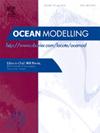Mechanism and application of the Lagrangian flow network method to indicate practical material distribution patterns in the tide-dominated Bohai Sea with multi-frequency tides
IF 2.9
3区 地球科学
Q2 METEOROLOGY & ATMOSPHERIC SCIENCES
引用次数: 0
Abstract
Mass transport process is vital for the spatial distribution of materials in coastal environments, and comprehending this process is essential for efficient marine pollution control and environmental conservation. As tides is an essential process in coastal environments, the patterns of practical material distribution are decoded in the tide-dominated Bohai Sea with multi-frequency tides by employing the Lagrangian flow network (LFN). Here, the parameter of degree represents the mass transport process, and the concept of the hydrodynamic province is used to depict the spatial distribution of passively transported materials. The emergent pattern of hydrodynamic provinces driven by multiple tidal constituents aligns with the climatological salinity trend, pollutant distribution and phytoplankton community in the springtime Bohai Sea, demonstrating the practical utility of the LFN. The mechanism elucidated by the LFN can be mainly attributed to the intertidal Lagrangian residual velocity induced by tides. Particularly in spring, the tide-induced residual current in the Bohai Sea significantly contributes to basin-scale circulation, while the wind-driven component in winter and the thermohaline part in summer play a more important role than those in spring. In the realm of marine management and conservation strategies, taking into account both terrestrial and maritime perspectives, and incorporation of the marine mass transport process is crucial for the formulation of effective policies.

拉格朗日流网法在渤海多频潮汐中指示实际物质分布规律的机理及应用
物质运输过程对沿海环境中物质的空间分布至关重要,了解这一过程对有效控制海洋污染和保护环境至关重要。由于潮汐是海岸带环境中必不可少的过程,本文利用拉格朗日流网(LFN)对多频潮汐占主导地位的渤海实际物质分布模式进行了解码。其中,程度参数代表质量输运过程,水动力省的概念用来描述被动输运物质的空间分布。多种潮汐组分驱动的水动力省涌现格局与渤海春季气候盐度趋势、污染物分布和浮游植物群落一致,表明了LFN的实际应用价值。LFN所阐明的机理主要归因于潮汐引起的潮间带拉格朗日残余速度。特别是在春季,渤海的潮致余流对海盆尺度环流的贡献显著,而冬季的风驱动分量和夏季的温盐分量比春季的作用更大。在海洋管理和养护战略方面,考虑到陆地和海洋的前景,并纳入海洋整体运输过程,对于制定有效的政策至关重要。
本文章由计算机程序翻译,如有差异,请以英文原文为准。
求助全文
约1分钟内获得全文
求助全文
来源期刊

Ocean Modelling
地学-海洋学
CiteScore
5.50
自引率
9.40%
发文量
86
审稿时长
19.6 weeks
期刊介绍:
The main objective of Ocean Modelling is to provide rapid communication between those interested in ocean modelling, whether through direct observation, or through analytical, numerical or laboratory models, and including interactions between physical and biogeochemical or biological phenomena. Because of the intimate links between ocean and atmosphere, involvement of scientists interested in influences of either medium on the other is welcome. The journal has a wide scope and includes ocean-atmosphere interaction in various forms as well as pure ocean results. In addition to primary peer-reviewed papers, the journal provides review papers, preliminary communications, and discussions.
 求助内容:
求助内容: 应助结果提醒方式:
应助结果提醒方式:


